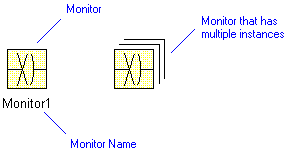Monitor (dictionary item)

For automation interface information about a Monitor, see
Monitor (automation interface).
The Monitor provides a higher level of data management than the Semaphore. It controls all shared resources through a set of variables, data structures and procedures. Tasks are allowed to enter the Monitor one at a time. By administering each task separately, the Monitor allows processes to perform multiple, uninterrupted functions on the data.
You can create a Monitor through the context menu of a Package: right-click the Package, point to > > > . In addition, you can create a Monitor through a Concurrency Diagram.
When used on a diagram, a Monitor's notation is as follows:

The following sections provide information about how a Monitor is used in the model. For more information about a property, item, model part or diagram, click it.
Properties
In addition to the
standard properties, a Monitor has these properties:
The Class box on the Options tab of a Monitor's Property Pages shows the Class, Data Type or Interface that owns the Operations that implement the Monitor. |
Owned by
Owns
 Dependency —The Dependency is owned jointly by the Monitor and the other associated item. The access permissions you have to a Dependency are determined by the access permissions of the dependent item.
Dependency —The Dependency is owned jointly by the Monitor and the other associated item. The access permissions you have to a Dependency are determined by the access permissions of the dependent item.Defined in these parts of the model
Shown on these diagrams
Can be linked to these dictionary items
 on the Monitor's icon indicates that the item is a
on the Monitor's icon indicates that the item is a
 Model
Model Package
Package Comment
Comment Constraint
Constraint Concurrency Model
Concurrency Model Concurrency Diagram
Concurrency Diagram Variant Diagram
Variant Diagram Class
Class Data Type
Data Type Interface
Interface Stereotype
Stereotype